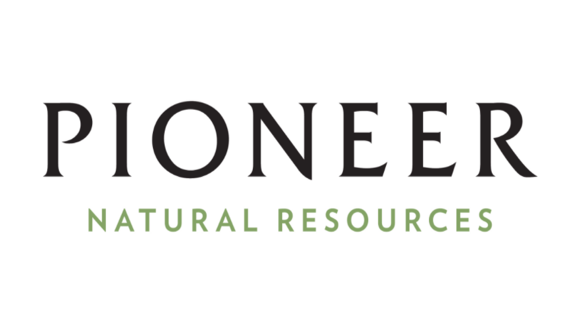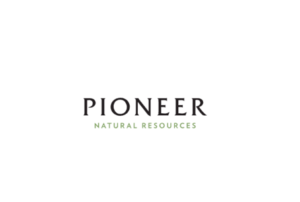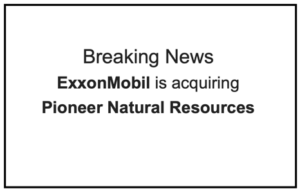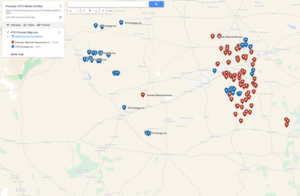Pioneer Natural Resources Company (NYSE:PXD) (“Pioneer” or “the Company”) today reported financial and operating results for the quarter ended September 30, 2021. Pioneer reported third quarter net income attributable to common stockholders of $1.0 billion, or $4.07 per diluted share. These results include the effects of noncash mark-to-market adjustments and certain other unusual items. Excluding these items, non-GAAP adjusted income for the third quarter was $1.1 billion, or $4.13 per diluted share. Cash flow from operating activities for the third quarter was $2.0 billion.
Pioneer Permit Download
Wells Drilled 2021
Air Permits
Highlights
- Delivered record free cash flow1 of $1.1 billion during the third quarter
- Announced divestiture of Delaware Basin assets for $3.25 billion, returning Pioneer to a pure-play operator in the high-margin, high-return Midland Basin
- Declared quarterly variable dividend of $3.02 per share to be paid during the fourth quarter, a 100% increase from the prior quarter variable dividend per share payment
- Increased quarterly base dividend to $0.62 per share, or $2.48 per share on an annualized basis, representing a greater than 10% increase from the prior quarter per share payment
- Averaged third quarter oil production of 389 thousand barrels of oil per day (MBOPD), in the upper half of guidance
- Averaged third quarter production of 676 thousand barrels of oil equivalent per day (MBOEPD), in the upper half of guidance
CEO Scott D. Sheffield stated, “Pioneer continues to execute at a high level, delivering another strong quarter and generating record quarterly free cash flow1 of $1.1 billion. Our peer-leading distribution framework will result in returning approximately 80% of third quarter free cash flow, or approximately $880 million, to shareholders through our base and variable dividend payments in the fourth quarter of 2021.
With the divestment of the Delaware Basin assets for $3.25 billion, Pioneer is 100% focused on developing its high-margin, high-return Midland Basin assets where we have decades of operating experience and the size and scale to generate significant free cash flow. This divestment strengthens our balance sheet and enables Pioneer to add opportunistic share repurchases during market dislocations to our capital return strategy.
Our strong financial and operational outlook is complemented by Pioneer’s commitment to sustainable practices as evidenced by our robust emission reduction goals and targets that we outline in our recently published 2021 Sustainability and Climate Risk reports. With our solid Environmental, Social and Governance (ESG) foundation and our unmatched investment framework, we believe our differentiated strategy will drive significant long-term value for Pioneer shareholders.”
Financial Highlights
Pioneer maintains a strong balance sheet, with unrestricted cash on hand at the end of the third quarter of $581 million and net debt of $6.3 billion. The Company had $2.6 billion of liquidity as of September 30, 2021, comprised of $581 million of unrestricted cash and a $2.0 billion unsecured credit facility (undrawn as of September 30, 2021).
During the third quarter, the Company’s drilling, completion and facilities capital expenditures totaled $960 million. The Company’s total capital expenditures2, including water infrastructure, totaled $982 million.
Cash flow from operating activities during the third quarter was $2.0 billion, leading to free cash flow1 of $1.1 billion.
The Company announced today that its Board of Directors has approved an increase in the Company’s quarterly cash base dividend from $0.56 per share to $0.62 per share, or $2.48 per share on an annualized basis. This payment represents a greater than 10% increase when compared to the base dividend paid in October 2021. Pioneer’s strong record of base dividend growth is demonstrated through the Company’s peer-leading five-year compound annual base dividend growth rate of 96%.
In addition to a strong base dividend, the Company’s investment framework provides significant shareholder returns through a quarterly cash variable dividend3 of up to 75% of the prior quarter’s free cash flow after deducting the base dividend paid during the prior quarter. For the fourth quarter, the Board of Directors has declared a quarterly cash variable dividend of $3.02 per share, or a total of approximately $740 million being returned to shareholders. This represents approximately 75% of the Company’s third quarter free cash flow after deducting the base dividend distributed in July.
Including the base and variable dividend, total dividend payments during the fourth quarter will be $3.58 per share, representing a current annualized yield of approximately 8% (based on the Company’s closing stock price as of October 29, 2021).
Pioneer’s balance sheet and leverage metrics continue to strengthen with the divestment of the Company’s Delaware Basin assets and the strong commodity price environment. This enhanced financial strength provides Pioneer with the flexibility to opportunistically return additional capital to shareholders through a share repurchase program during market dislocations. The Company has $1.1 billion of remaining capacity under a $2 billion share repurchase program that was authorized during the fourth quarter of 2018. Pioneer believes this peer-leading return of capital strategy, which combines a base dividend, a substantial variable dividend and opportunistic share repurchases, creates significant long-term value for shareholders.
Third Quarter Financial Results
For the third quarter of 2021, the average realized price for oil was $69.24 per barrel. The average realized price for natural gas liquids (NGLs) was $35.66 per barrel, and the average realized price for gas was $4.05 per thousand cubic feet. These prices exclude the effects of derivatives.
Production costs, including taxes, averaged $8.09 per barrel of oil equivalent (BOE). Depreciation, depletion and amortization (DD&A) expense averaged $11.32 per BOE. Exploration and abandonment costs were $10 million. General and administrative (G&A) expense was $72 million. Interest expense was $41 million. The net cash flow impact related to purchases and sales of oil and gas, including firm transportation, was a loss of $83 million. Other expense was $34 million, or $26 million excluding unusual items4.
Operations Update
During the third quarter, Pioneer continued to deliver strong operational efficiency gains that enabled the Company to place 142 horizontal wells on production. Drilling and completion efficiency improvements have resulted in a 70% increase in drilled feet per day and an 80% increase in completed feet per day when compared to 2017 averages. The Company continues to see benefits from utilizing simulfrac technology and plans to run two simulfrac fleets during the remainder of 2021. These efficiency improvements continue to benefit the Company’s capital program and capital efficiency metrics.
2021 Outlook
The Company expects its 2021 drilling, completions and facilities capital budget to range between $2.95 billion to $3.25 billion. An additional $100 million and $50 million is budgeted for integration expenses related to the acquisitions of Parsley and DoublePoint, respectively, resulting in a total 2021 capital budget2 range of $3.1 billion to $3.4 billion. The Company expects its capital program to be fully funded from forecasted 2021 cash flow5 of $6.55 billion.
During 2021, the Company plans to operate an average of 22 to 24 horizontal drilling rigs in the Permian Basin, including a one-rig average program in the Delaware Basin and a three-rig average program in the southern Midland Basin joint venture area. The 2021 capital program is expected to place approximately 535 wells on production. Pioneer expects 2021 oil production of 356 to 359 MBOPD and total production of 613 to 619 MBOEPD, reflecting the impact of the Glasscock acreage divestiture that closed in October 2021.
Pioneer’s investment framework prioritizes free cash flow generation and return of capital to shareholders. This capital allocation strategy is intended to create long-term value by limiting the reinvestment of cash flow to enhance the Company’s free cash flow profile while targeting a long-term leverage ratio of 0.5 times net debt to EBITDAX. This investment framework is expected to deliver a mid-teens total annual return, inclusive of a strong and growing base dividend, a significant variable dividend and high-return oil growth. Pioneer’s investment framework is further augmented by the ability to fund opportunistic share repurchases during market dislocations. The Company believes this differentiated strategy positions Pioneer to be competitive across industries.
The Company’s financial and derivative mark-to-market results and open derivatives positions are outlined in the attached schedules.
Fourth Quarter 2021 Guidance
Fourth quarter 2021 oil production is forecasted to average between 388 to 403 MBOPD and total production is expected to average between 670 to 695 MBOEPD, reflecting the impact of the Glasscock acreage divestiture that closed in October 2021. Production costs are expected to average $7.50 per BOE to $9.00 per BOE, reflecting the impact of higher commodity prices on forecasted production taxes. DD&A expense is expected to average $10.75 per BOE to $12.75 per BOE. Total exploration and abandonment expense is forecasted to be $10 million to $20 million. G&A expense is expected to be $67 million to $77 million. Interest expense is expected to be $39 million to $44 million. Other expense is forecasted to be $15 million to $30 million. Accretion of discount on asset retirement obligations is expected to be $2 million to $5 million. The cash flow impact related to purchases and sales of oil and gas, including firm transportation, is expected to be a loss of$45 million to $75 million, based on forward oil price estimates for the quarter. The Company’s effective income tax rate is expected to be between 22% to 27%.
Environmental, Social & Governance (ESG)
Pioneer views sustainability as a multidisciplinary focus that balances economic growth, environmental stewardship and social responsibility. The Company emphasizes developing natural resources in a manner that protects surrounding communities and preserves the environment.
During the third quarter, Pioneer published its 2021 Sustainability Report, highlighting the Company’s focus and significant progress on its ESG initiatives. The report highlights the Company’s Net Zero ambition by 2050 for both Scope 1 and Scope 2 and enhanced emissions reduction targets for greenhouse gas (GHG) and methane. In addition, the report details the Company’s 2020 performance in a variety of ESG related endeavors.
Many key initiatives are underway that will result in tangible progress towards the Company’s planned pathway to reach Net Zero. In support of this, Pioneer achieved a 27% reduction in GHG emission intensity and a 50% reduction in methane intensity in 2020, when compared to a 2019 baseline, exceeding the Company’s previously established targets. With this achievement, Pioneer has strengthened its 2030 emission reduction goals to a 50% reduction in GHG intensity and a 75% reduction in methane intensity from the Company’s 2019 baseline. Additionally, the Company achieved a flaring intensity that was 79% lower in 2020 than Pioneer’s goal to limit flaring to 1% of natural gas produced. As previously disclosed, the Company plans to end routine flaring, as defined by the World Bank, by 2030, with an aspiration to reach this goal by 2025.
In addition to emissions related goals, Pioneer is adopting a target to reduce freshwater use in the Company’s completion operations to less than 25% by 2026. Pioneer expects to achieve this goal by expanding the Company’s recycling capabilities and through its unique partnerships with the cities of Midland and Odessa to utilize reclaimed water. Pioneer has already achieved a 50% reduction in freshwater use from its 2015 completions baseline.
Pioneer recently published the Company’s first Climate Risk Report, which increases the transparency of Pioneer’s progress toward integrating climate-related risks and opportunities into the Company’s governance structure, business strategy and planning process, and risk management practice. The report is structured in accordance with the four core principles of the Task Force on Climate-related Financial Disclosures (TCFD): governance, strategy, risk management, and metrics and targets.
Socially, Pioneer maintains a proactive safety culture, supports a diverse workforce and inspires teamwork to drive innovation. The Board of Directors’ Health, Safety and Environment (HSE) and Nominating and Corporate Governance Committees provide director-level oversight of these activities. These committees help to promote a culture of continuous improvement in the Company’s diversity, equity and inclusion and safety and environmental practices. As part of this ongoing effort, the Pioneer Board of Directors expanded the responsibilities of its Sustainability and Climate Oversight Committee to provide additional oversight and strategic direction in sustainability and climate matters at the Company. Consistent with the high priority placed on HSE and ESG, the Board of Directors increased the executive annual incentive compensation weighting for these metrics from 10% to 20% in 2021.
In addition to the increased weighting towards HSE and ESG metrics, Pioneer’s executive incentive compensation continues to be aligned with shareholder interests. Beginning in 2021, return on capital employed (ROCE) has been included as an incentive compensation metric, along with cash return on capital invested (CROCI), which was added in 2020. These metrics have a combined weighting of 20%, while the production and reserves goals that were previously included as incentive compensation metrics have been removed.
Pioneer has amended executive equity compensation as well, with the S&P 500 index being added into the total stockholder return (TSR) peer group for performance awards beginning in 2021, and, for the second consecutive year, the long-term equity compensation for the Company’s Chief Executive Officer will be 100% in performance awards, with 100% of such awards being “at-risk” based on performance relative to the TSR peer group. These updates to Pioneer’s executive incentive and equity compensation programs demonstrate the Company’s continuing commitment to aligning total executive compensation with the interests of our shareholders.
More About Pioneer









